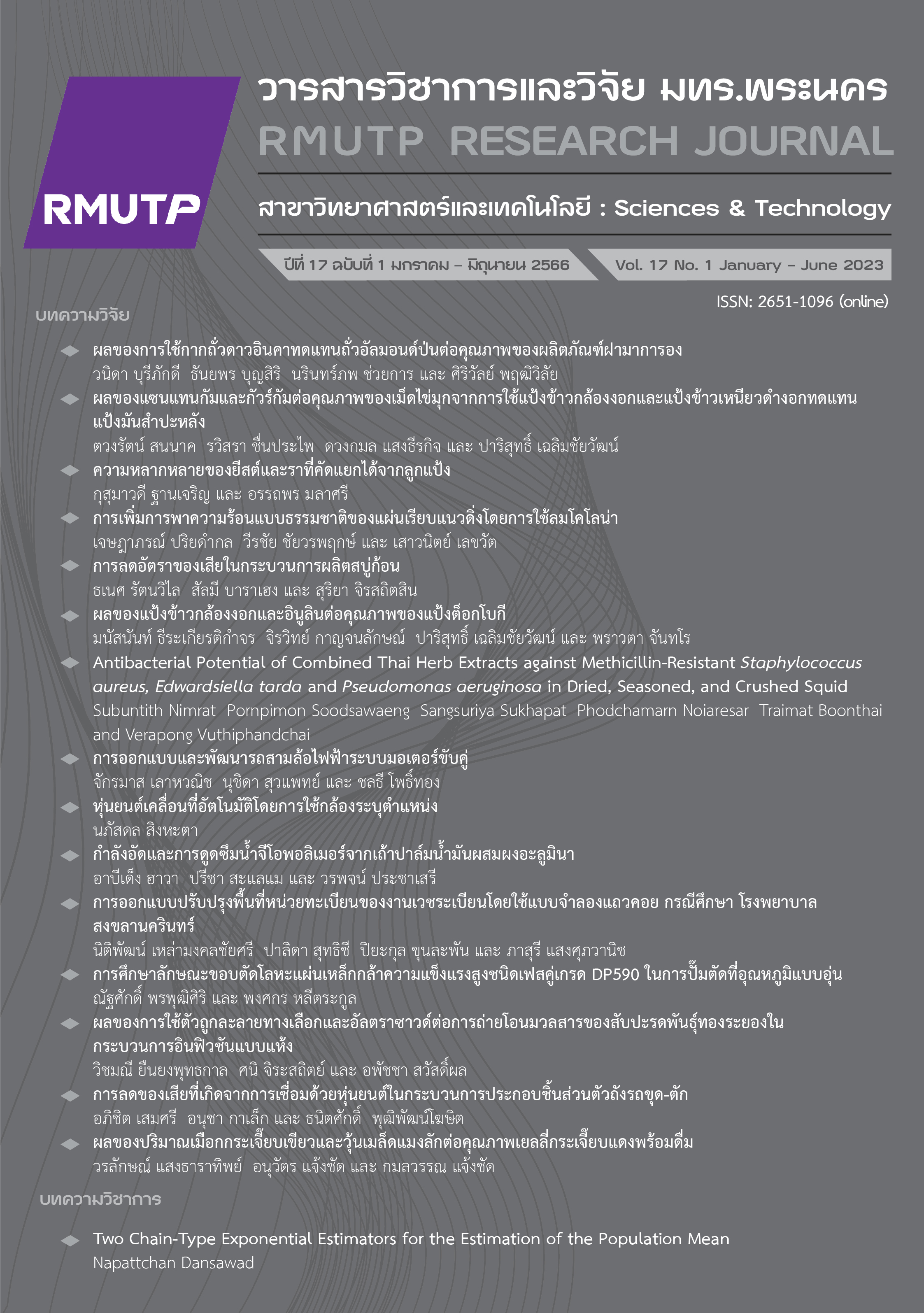ผลของปริมาณเมือกกระเจี๊ยบเขียวและวุ้นเมล็ดแมงลักต่อคุณภาพเยลลี่กระเจี๊ยบแดงพร้อมดื่ม
Main Article Content
บทคัดย่อ
กระเจี๊ยบเขียว และเมล็ดแมงลัก เป็นพืชสมุนไพรไทยและเป็นแหล่งของใยอาหารที่ดีให้ประโยชน์ต่อสุขภาพของผู้บริโภค เมือกและวุ้นที่ได้จากกระเจี๊ยบเขียวและเมล็ดแมงลักมีลักษณะเป็นเจล ซึ่งเป็นสมบัติที่ดีในการเป็นวัตถุดิบหลักของผลิตภัณฑ์เยลลี่พร้อมดื่ม งานวิจัยนี้มีวัตถุประสงค์เพื่อพัฒนาผลิตภัณฑ์เยลลี่กระเจี๊ยบพร้อมดื่มเสริมคุณค่าทางโภชนาการจากกระเจี๊ยบเขียวและเมล็ดแมงลัก เพื่อเป็นผลิตภัณฑ์ทางเลือกสำหรับผู้บริโภคที่ดูแลสุขภาพ ในการเตรียมวัตถุดิบ พบว่า เมือกกระเจี๊ยบเขียวและวุ้นเมล็ดแมงลักมีผลผลิต ร้อยละ 38.7 และ 73.7 ตามลำดับ จากการศึกษาผลของปริมาณเมือกกระเจี๊ยบเขียว วุ้นเมล็ดแมงลัก และน้ำในผลิตภัณฑ์เยลลี่กระเจี๊ยบพร้อมดื่มต่อคะแนนความชอบในคุณลักษณะด้านต่าง ๆ โดยวางแผนการทดลองแบบ Mixture design ซึ่งมีจำนวน 7 สิ่งทดลอง พบว่า เมื่อปริมาณเมือกกระเจี๊ยบเขียวและวุ้นเมล็ดแมงลักเพิ่มขึ้นส่งผลให้คะแนนความชอบด้านกลิ่นรสโดยรวม เนื้อสัมผัส รสหวาน รสเปรี้ยว และความชอบโดยรวมลดลง อย่างมีนัยสำคัญทางสถิติ (p≤0.05) ปริมาณเมือกกระเจี๊ยบเขียวและน้ำมีอิทธิพลต่อคะแนนความชอบมากกว่าวุ้นเมล็ดแมงลัก การศึกษาผลของปริมาณแคปปาคาราจีแนนที่ ร้อยละ 0.00, 0.25 และ 0.50 ต่อคุณภาพผลิตภัณฑ์เยลลี่พร้อมดื่ม พบว่า เมื่อปริมาณแคปปาคาราจีแนนเพิ่มขึ้น ส่งผลให้ค่าความแข็งเพิ่มขึ้นอย่างมีนัยสำคัญทางสถิติ (p≤0.05) โดยแคปปาคาราจีแนน ร้อยละ 0.25 มีคะแนนความชอบด้านเนื้อสัมผัสและความชอบโดยรวมสูงที่สุด สูตรที่เหมาะสมของเยลลี่กระเจี๊ยบพร้อมดื่มมีอัตราส่วนของ เมือกกระเจี๊ยบเขียว วุ้นเมล็ดแมงลัก และน้ำ เท่ากับ 1:1:3 และปริมาณแคปปาคาราจีแนน ร้อยละ 0.25
Article Details

This work is licensed under a Creative Commons Attribution-NonCommercial-NoDerivatives 4.0 International License.
ลิขสิทธ์ ของมหาวิทยาลัยเทคโนโลยีราชมงคลพระนครReferences
USDA. (2018). FoodData Central: Okra (raw). [Online]. Available: https://fdc.nal.usda.gov/fdc-app.html#/food-etails/169260/nutriaents
A. Roy, S. L. Shrivastava and S. M. Mandal, “Functional properties of Okra Abelmoschus esculentus L. (Moench): traditional claims and scientific evidences,” Plant Science Today, no. 3, pp. 121-130, 2014.
H. F. Gemede, N. Ratta, G. D. Haki, A. Z. Woldegiorgis and F. Bey, “Nutritional Quality and Health Benefits of Okra (Abelmoschus Esculentus): A Review,” Global Journal of Medical Research, vol. 14, no. 5, 2014.
K. Alba, A. P. Laws and V. Kontogiorgos, “Isolation and characterization of acetylated LM-pectins extracted from okra pods,” Food Hydrocolloids, vol. 43, pp. 726-735, 2015.
V. Kontogiorgos, I. Margelou, N. Georgiadis and C. Ritzoulis, “Rheological characterization of okra pectins,” Food Hydrocolloids, vol. 29, no. 2, pp. 356-362, 2012.
H. Wang, G. Chen, D. Ren and S.-T. Yang, “Hypolipidemic Activity of Okra is Mediated Through Inhibition of Lipogenesis and Upregulation of Cholesterol Degradation,” Phytotherapy Research, vol. 28, no. 2, pp. 268-273, 2014.
S. Fan, Y. Zhang, Q. Sun, L. Yu, M. Li, B. Zheng, X. Wu, B. Yang, Y. Li and C. Huang, “Extract of okra lowers blood glucose and serum lipids in high-fat diet-induced obese C57BL/6 mice,” The Journal of Nutritional Biochemistry, vol. 25, no. 7, pp. 702-709, 2014.
L. G. Monte, T. Santi-Gadelha, L. B. Reis, E. Braganhol, R. F. Prietsch, O. A. Dellagostin, R. R. e Lacerda, C. A. A. Gadelha, F. R. Conceicao and L. S. Pinto, “Lectin of Abelmoschus esculentus (okra) promotes selective antitumor effects in human breast cancer cells,” Biotechnology Letters, vol. 36, no. 3, pp. 461-469, 2014.
F. Kurd, M. Fathi and H. Shekarchizadeh, “Basil seed mucilage as a new source for electrospinning: Production and physicochemical characterization,” International Journal of Biological Macromolecules, vol. 95, pp. 689-695, 2017.
S. Naji-Tabasi and S. M. A. Razavi, “Functional properties and applications of basil seed gum: An overview,” Food Hydrocolloids, vol. 73, pp. 313-325, 2017.
S. H. Hosseini-Parvar, L. Matia-Merino, K. K. T. Goh, S. M. A. Razavi and S. Mortazavi, “Steady shear flow behavior of gum extracted from Ocimum basilicum L. seed: Effect of concentration and temperature,” Journal of Food Engineering, vol. 101, no. 3, pp. 236-243, 2010.
Sukrichaya Hemathulin and Kannika Sombun, “The Functional Mao (Antidesma bunius) Jelly Drink with Mucilage,Biological Extracts from Hairy Basil Seed,” KHON KAEN AGR. J., vol. 43, SUPPL. 1, 2015.
A. Hajmohammadi, M. Pirouzifard, M. Shahedi and M. Alizadeh, “Enrichment of a fruit-based beverage in dietary fiber using basil seed: Effect of Carboxymethyl cellulose and Gum Tragacanth on stability,” LWT, vol. 74, pp. 84-91, 2016.
Thai Community Products Standards, TCPS Number 518/2547, 2004.
W. R. Blakemore and A. R. Harpell, “Carrageenan,” in Food Stabilisers, Thickeners and Gelling Agents, A. Imeson, 1st ed. UK: Blackwell Publishing, 2010, pp. 73-93.
S. Rattanatavon, P. Siriphunt and S. Vatthanakul, “Development of banana flavor carrageenan jelly drink fortifie with banana peel extracts,” International journal of agricultural technology, vol. 16, no. 3, pp. 685-694, 2020.
S. Gisbert. (2018). What's trending in Thai functional drinks [Online]. Available: https://clients.mintel.com/report/what-s-trending-in-thai-functional-drinks
B. Sugara, K. Ambarwati and E. Damayanthi, “Mineral bioavailability in jelly drink made of green okra (Abelmoschus esculentus) and strawberry (Fragaria ananassa) extract,” IOP Conference Series: Earth and Environmental Science, vol. 196, p. 012007, 2018.
U. Farooq, R. Malviya and P. K. Sharma, “Extraction and characterization of okmucilage as pharmaceutical excipient,” Academic Journal of Plant Sciences, vol. 6, pp. 168-172, 2013.
S. M. A. Razavi, S. A. Mortazavi, L. Matia-Merino, S. H. Hosseini-Parvar, A. Motamedzadegan and E. Khanipour, “Optimisation study of gum extraction from Basil seeds (Ocimum basilicum L.),” International Journal of Food Science & Technology, vol. 44, no. 9, pp. 1755-1762, 2009.
S. Nazir, I. A. Wani and F. A. Masoodi, “Extraction optimization of mucilage from Basil (Ocimum basilicum L.) seeds using response surface methodology,” Journal of Advanced Research, vol. 8, no. 3, pp. 235-244, 2017.
N. Nazir and M. R. Adrian, “The improvement lycopene availability and antioxidant activities of tomato (Lycopersicum Esculentum, Mill) Jelly Drink,” Agriculture and Agricultural Science Procedia, vol. 9, pp. 328-334, 2016.
J. Hurler, A. Engesland, B. Poorahmary Kermany and N. Škalko-Basnet, “Improved texture analysis for hydrogelcharacterization: Gel cohesiveness, adhesiveness, and hardness,” Journal of Applied Polymer Science, vol. 125, no. 1, pp. 180-188, 2012.
B. Mgaya-Kilima, S. F. Remberg, B. E. Chove and T. Wicklund, “Influence of storage temperature and time on the physicochemical and bioactive properties of roselle-fruit juice blends in plastic bottle,” Food Science & Nutrition, vol. 2, no. 2, pp. 181-191, 2014.

